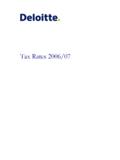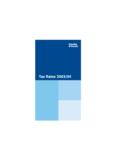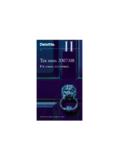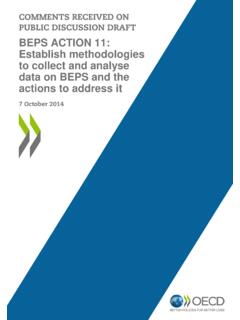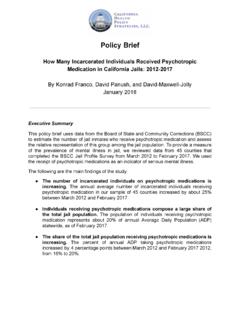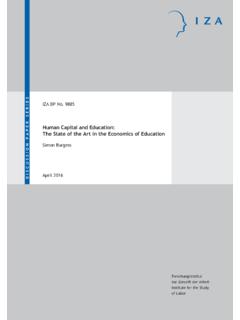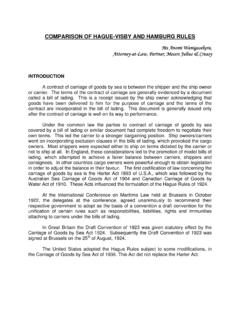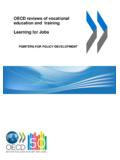Transcription of Tax rates 2016/17 Listen. Analyse. Apply. - Deloitte UK
1 UK Budget 2016 Tax rates 2016 /17 Listen. Analyse. Tax 1 Indirect taxes 12 National Insurance contributions 19 Business tax 21 Offices 27 These tables are a summary and do not cover all situations. They are based on information in the Budget announcements on 16 March 2016 . These may be subject to further amendment. This publication has been written in general terms and therefore cannot be relied on to cover specific situations; application of the principles set out will depend upon the particular circumstances involved and we recommend that you obtain professional advice before acting or refraining from acting on any of the contents of this TaxIncome tax rates 2016 /17 (2015/16)Income band ( )Dividends (%)Other savings income (%)Up to 32,000 (up to 31,785) a, (10%, effective rate 0%)2032,000 150,000 (31,786 150,000) ( , effective rate 25%)40 Over 150,000 (over 150,000) ( , effective rate ) 45 Income band ( )Other income (%)Cumulative tax ( )Up to 32,000 (up to 31,785)Basic rate: 206,400 (6,357)32,000 150,000 (31,786 150,000)Higher rate: 4053,600 (53,643)Over 150,000 (over 150,000)Additional rate: 45a.
2 A 0% starting rate applies to the first 5,000 of savings income. For many taxpayers this is not relevant as the starting rate does not apply if their taxable non savings income exceeds the starting rate Subject to the Personal Savings and Dividend income bands are broadly used in the following order: Non savings income Savings income DividendsFrom 2016 /17, the 10% notional dividend tax credit has been abolished. Instead a Dividend Allowance of 5,000 per year (0% rate) has been introduced. Discretionary trusts and accumulation and maintenance trusts are entitled to a standard rate band of 1,000. Income in excess of this amount is subject to income tax at the top rate of income tax which is 45%. The rate of tax on dividend income received in excess of the standard rate band in 2016 /17 is (2015/16: ).The higher rate band will increase to 33,500 for 2017/18.
3 1 Tax rates 2016 /17 Listen. Analyse. allowances2016/17 ( )2015/16 ( )Individual a, d, e11,00010,600 Married couple (elder aged 81 and over) b, c, d8,3558,355 Personal Savings Allowance for basic rate taxpayers f 1,000 Personal Savings Allowance for higher rate taxpayers f 500 Dividend Allowance g 5,000 a. Reduced by 1 for each 2 of income (less deductions) in excess of 100, Reduced by 1 for each 2 of income (less deductions) which exceeds 27,700. The minimum age related married couple s allowance is 3, Restricted to relief at 10%.d. None of these allowances are available to non UK domiciled individuals who elect to pay tax on the remittance basis of Spouses or civil partners will be able to transfer 1,100 ( 1,060) of their unused personal allowance to their partner. This is available provided neither person pays tax at the higher rate.
4 F. A 0% tax rate for personal savings income for basic and higher rate taxpayers A 0% tax rate for dividend income available to all UK resident personal allowance for 2017/18 will be 11,500. In Budget 2016 , the Government announced that two new 1,000 allowances for property income and trading income will be introduced from 2017 tax reliefs and incentivesAnnual limits2016/17 ( )Enterprise Investment Scheme (EIS) (maximum) a1,000,000 Seed Enterprise Investment Scheme (SEIS) (maximum) b100,000 Venture Capital Trust (VCT) (maximum) c200,000 Employee shareholder status d2,000 Individual Savings Account (ISA) (maximum) e15,240 Junior ISA (maximum per child) 4,080a. Income tax relief restricted to 30%. CGT deferral on gains on disposal of other assets is also Rate of income tax relief is 50%. The relief applies to shares in qualifying trading companies with less than 25 full time equivalent employees, and assets of up to 200,000 issued after 6 April 2012.
5 Maximum stake 30% of share capital and voting rights. Total SEIS financing per company is limited to 150,000 cumulatively (within three years preceding the share issue).c. Rate of income tax relief for investors in VCTs is 30%. Dividends received on qualifying VCT investments are exempt from income The first 2,000 of shares acquired by an employee under the employee shareholder provisions will be free of income tax and national insurance A Help to Buy ISA enables first time buyers saving up to 200 per month plus an initial amount of up to 1,000 towards their first home to receive a government bonus of 25% of the amount saved. The Government will contribute a maximum of 3,000 on 12,000 of savings. The overall annual ISA subscription limit will be increased to 20,000 from 2017 Budget 2016 , the Government announced that a new Lifetime ISA will be introduced from April 2017.
6 Adults under the age of 40 will be able to contribute up to 4,000 per year, and receive a 25% bonus from the Government. Any contribution to this new Lifetime ISA counts towards the overall ISA subscription is available at the taxpayer s marginal rate of income tax for charitable donations via the Gift Aid and Payroll Giving schemes and for charitable gifts of quoted shares and securities and real rates 2016 /17 Listen. Analyse. allowance ( ) 40,000 b, c80,000 a, cLifetime allowance ( ) 1,000,000 d, e1,250,000 d a. The 2015/16 annual allowance was initially 40,000, but was increased to 80,000 due to transitional rules that were announced on 8 July 2015. The amount that is available for use between 9 July 2015 and 5 April 2016 cannot exceed 40,000 (ie the first 40,000 is only available for pension savings made on or before 8 July 2015).
7 B. From 2016 /17 the annual allowance will be reduced by 1 for every 2 of income over 150,000, including relievable contributions, to a minimum of 10, The annual allowance may be increased by up to 130,000 (2015/16: 140,000) with unused relief from the previous three years. Where the member has flexibly accessed his uncrystallised or drawdown fund since then, the annual allowance for contributions to a money purchase scheme is 10,000, with no unused allowance brought forward see further comments below. The potentially higher limit for defined benefit schemes The standard lifetime allowance, which is the total value of pension savings that can be accumulated without a tax recovery charge when a pension or lump sum is taken, reduced from to from 6 April 2014. Individuals who have previously elected transitional protection by reference to their position in April 2006, April 2012 or April 2014 continue to benefit from higher limits.
8 For instance, members who claimed fixed protection 2014 and opted out of further pension saving by April 2014 may retain the limit. Members whose savings at April 2014 exceeded may by 5 April 2017 elect for individual protection which freezes their tax free limit at the 6 April 2014 funding level (subject to a cap) but allows them to continue contributing, on the basis that future fund growth is subject to a tax recovery A new form of individual protection is expected to be introduced for individuals with savings above 1m to secure an allowance between 1m and Similarly, a new form of fixed protection should enable individuals to retain the allowance if they opt out of further pension savings by 5 April 2016 . 4 Aggregate contributions made by employers and employees to a money purchase (defined contribution) registered pension scheme attract an annual allowance charge to the extent they exceed the annual allowance for the tax year in which the pension input period ends, augmented by any brought forward unused relief from the previous three years.
9 No charge arises where the member dies in the year or is medically assessed as unable to work ever again. An annual allowance charge similarly applies to salary related pension accrual where the inflation adjusted increase in pension entitlement, multiplied by a valuation factor of 16, exceeds the annual limit. No charge applies where the member s active participation in the scheme has ceased. Where the annual limit is exceeded, tax is payable on the excess at the individual s marginal (ie 20%, 40% or 45%) rate. This is normally payable by the individual via self assessment, but in some cases they may elect for the pension scheme to pay the tax drawing a pension, the maximum tax free pension commencement lump sum payable is the lesser of 25% of the value of an individual s uncrystallised fund, 25% of the member s lifetime allowance and one third of the amount crystallised for the payment of a pension or annuity for life, or as funds available for drawdown.
10 Subject to the agreement of the scheme administrator, members of money purchase schemes who have reached the minimum pension age of 55 will be able to take funds from their drawdown account flexibly whenever they want, and in any desired amount. Members will also have the option of taking an uncrystallised funds pension lump sum , 25% of which is tax free, provided they have sufficient lifetime allowance available. If the member dies before age 75 any unused drawdown or undrawn uncrystallised funds can be paid to dependants free of tax. After that age lump sums are taxable. In 2015/16 death benefit lump sums are subject to a flat tax rate of 45%. From 6 April 2016 , they will normally be taxed as pension income of the recipient (ie marginal income tax rates ).5 Tax rates 2016 /17 Listen. Analyse. certain circumstances, including when a member takes a pension or lifetime annuity, designates funds for drawdown, dies holding uncrystallised funds or takes a pension commencement or uncrystallised funds pension lump sum, his aggregate pension savings are also tested against the lifetime limit, taking account of any previous benefit crystallisation event.
